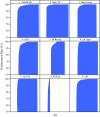Benchmarking the American Society of Breast Surgeon Member Performance for More Than a Million Quality Measure-Patient Encounters
- PMID: 29168099
- PMCID: PMC5758679
- DOI: 10.1245/s10434-017-6257-9
Benchmarking the American Society of Breast Surgeon Member Performance for More Than a Million Quality Measure-Patient Encounters
Abstract
Background: Nine breast cancer quality measures (QM) were selected by the American Society of Breast Surgeons (ASBrS) for the Centers for Medicare and Medicaid Services (CMS) Quality Payment Programs (QPP) and other performance improvement programs. We report member performance.
Study design: Surgeons entered QM data into an electronic registry. For each QM, aggregate "performance met" (PM) was reported (median, range and percentiles) and benchmarks (target goals) were calculated by CMS methodology, specifically, the Achievable Benchmark of Care™ (ABC) method.
Results: A total of 1,286,011 QM encounters were captured from 2011-2015. For 7 QM, first and last PM rates were as follows: (1) needle biopsy (95.8, 98.5%), (2) specimen imaging (97.9, 98.8%), (3) specimen orientation (98.5, 98.3%), (4) sentinel node use (95.1, 93.4%), (5) antibiotic selection (98.0, 99.4%), (6) antibiotic duration (99.0, 99.8%), and (7) no surgical site infection (98.8, 98.9%); all p values < 0.001 for trends. Variability and reasons for noncompliance by surgeon for each QM were identified. The CMS-calculated target goals (ABC™ benchmarks) for PM for 6 QM were 100%, suggesting that not meeting performance is a "never should occur" event.
Conclusions: Surgeons self-reported a large number of specialty-specific patient-measure encounters into a registry for self-assessment and participation in QPP. Despite high levels of performance demonstrated initially in 2011 with minimal subsequent change, the ASBrS concluded "perfect" performance was not a realistic goal for QPP. Thus, after review of our normative performance data, the ASBrS recommended different benchmarks than CMS for each QM.
Figures
References
-
- Kohn LT, Corrigan J, Donaldson MS. To err is human: building a safer health system. Institute of Medicine (US) Committee on Quality of Health Care in America. Washington (DC): National Academies Press (US); 2000. - PubMed
MeSH terms
Grants and funding
LinkOut - more resources
Full Text Sources
Other Literature Sources
Medical
Miscellaneous


